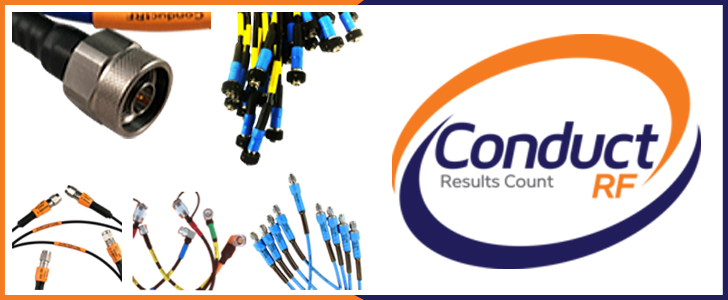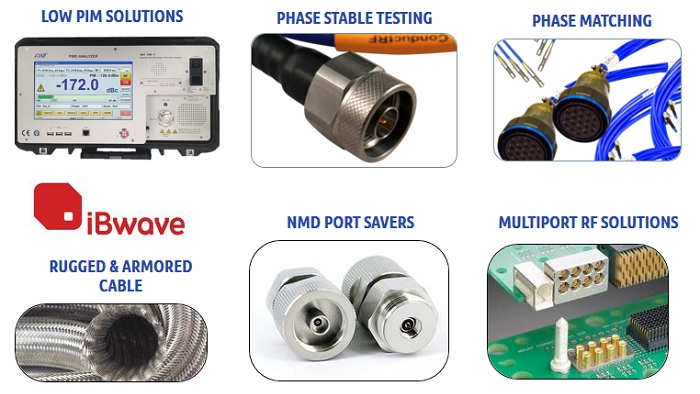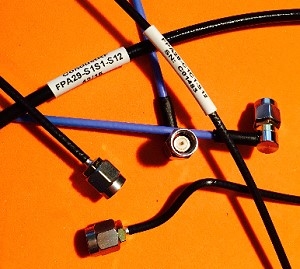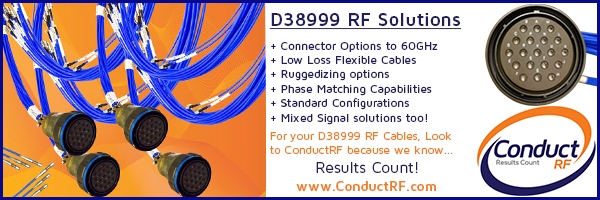
 everything RF Interviewed Dean Gammell, National Sales Manager, ConductRF, a manufacturer of RF interconnect solutions from DC to 110 GHz and is focused on providing a broad offering to diverse market. They have been in the RF Interconnect industry for nearly 15 years, successfully supporting high performance solutions that require precision and expertise to bring to life.
everything RF Interviewed Dean Gammell, National Sales Manager, ConductRF, a manufacturer of RF interconnect solutions from DC to 110 GHz and is focused on providing a broad offering to diverse market. They have been in the RF Interconnect industry for nearly 15 years, successfully supporting high performance solutions that require precision and expertise to bring to life.
Dean Gammell leads customer facing efforts for ConductRF and manage the product support strategy focused on key customers and markets with a heavy emphasis on application engineered solutions.
Q. Can you give us a brief history about Conduct RF? When was the company founded, and what was the objective of the company when it was founded?
ConductRF was conceived and launched in 2014 as the primary brand representing the RF Connector and Cable assembly capabilities of Electronic Assemblies Mfg. Inc. (EAM). We felt that our company name EAM, did not fully represented our capabilities and did not convey the value propositions we were offering to our customers. Our brand ConductRF better represents our RF expertise and focus so that customers have a more accurate understanding of the intentions in our support. EAM was originally founded in 1997 as a build to print assembler supporting local New England customers, however, by 2002, the company’s major focus had already become established with a heavy emphasis on RF applications. Company investments in equipment and people from that time on have continued in that direction. EAM’s growth in RF largely went unnoticed by many because of the significant level of business that was private labelled for others. Introducing ConductRF was effectively creating our own Private Label for our capabilities.
Q. What products and services do you provide?

ConductRF’s goal is to offer engineered RF solutions for every application and requirement involving interconnect. Today, this means that we must offer a broad range of RF connector products as well as extensive cable assembly capabilities. Below this top level of Connectors and Assemblies we have additional separation in to Standard/Commercial and Precision/Test. It is the next level down we start getting to ranges of specific products and solutions for specific applications. Having a broad capability that provides support for applications from DC to 110 GHz means we already pretty much cover most frequency requirements in use in commercial and military systems.
In addition, we support a wide array of niche applications including many Test & Measurement solutions, like our 110 GHz VNA Test Cables, all the way to Low PIM connectors and cable assemblies for DAS infrastructure for installation in to stadiums and campuses in North America.
To support such diversity in products, processes and costs we operate a broad set of manufacturing strategies that focus on the differences required in manufacturing as opposed to the standard commonality. The most obvious example of this is in our Connector ranges. We have a Standard range of products that focus of commercial applications that must be cost effective and high quality. These are manufactured in China and Taiwan. Our Precision Ranges have some similar parts, but the materials and operating frequencies require manufacturing & design differences so in support of this, we produce these primarily in the United States, with some parts produced in Japan and South Korea too. This separation allows us to easily implement different validation and standards for the different products. Common manufacturing process always try to exploit economies of scale and that usually means excessive cost for commercial parts or lowered standards on precision. We just accept that they are better support entirely differently. For ConductRF, appropriate performance, cost and availability are of critical importance to the value we hope to bring to our customers and we don't want a customer to be forced in to a bad fitting solution just because that’s only one that best fits our plans.
Q. What differentiates Conduct RF from the other Cable Assembly Manufacturers?
ConductRF offers performance-based solutions cost effectively and with speed. We put a lot of effort in to understanding our customer’s applications and technical needs so that when we offer a solution, it doesn’t just meet the commercial requirements, but for the engineers involved, we also support their technical objectives. We offer advice based on our broad market place knowledge and we try to speak in terms relevant to the customer use and application rather than in the language of cable and connectors people. From a product stand point, it is critical to deliver on your technical and commercial commitments and this has a very high priority in the expectations we place on ourselves. In terms of product performance, our skills in Phase Matching to tight specifications as well as our broad frequency capability mean we are one of only handful of companies that can offer competitive solutions for such a broad set of RF applications. The really tough part is the Hi-Frequency and that separates us from many companies alone.
Q. What market segments do you cater to? Can you give us a percentage breakup of these segments? Do you see this changing in the next few years?
ConductRF’s business is split pretty evenly between Test & Measurement (T&M) which cover about 30% of what we produce monthly, Commercial Communication solutions represent another 30% and the balance is Military/Aerospace or Government/NGO focused solutions. The scale of our support in T&M provides the backbone for much of our technical excellence across all of our products. As a manufacturer, we suspect that EAM has been manufacturing more than 15% of the T&M RF cables consumed in the United States for several years for applications at & above 18 GHz.
Q. What does Conduct RF's geographic distribution of customers look like? Do you expect this to change over the next few years?
In early 2017, we introduced our ConductRF Primary Test and Measurement Cable assembly ranges to the world through Premier Farnell. Newark in North America, Element 14 in Asia and Farnell in Europe. Having a global franchised distributor has helped us share our brand and capabilities on a more global scale, but we are still in the early days of this relationship and we have more to do. In 2018 and 2019 we are planning to add regional distributors that have established territories and customer bases that can provide a closer level of support and design-in that can then help more customers with support for our non T&M products.
Q. Which products do you manufacture in the US vs Asia – Is this based on the geography of the customer or does each factory have different capabilities?
Our own factory is based in Methuen, MA and we conduct all support and activity from this location. Our manufacturing however extends globally through several key partnerships around the world. Our raw cables are manufactured in the United States, S. Korea and Japan. Our Connectors are manufactured also in these locations but also, we have support in China and Taiwan. Much of the interconnect industry today relies substantially on sub-contract manufacturing rather than full vertical integration themselves. This strategy allows us to support a much broader level of customer support which is a primary objective. In these instances, our focus is on design, process control and final quality control. Speed and cost advantages can be big beneficiaries of such a strategy and customers are always interested in this. Our own facility tends to support more precision assemblies, T&M requirements, ITAR projects and start up development applications.
Q. ConductRF has a wide range of Test Cables - What is are some important factors/specs that users should evaluate for when selecting a test cable?

Stability is a critical element of all Test Cables. It is often the difference in quality and lack of it is a common failure mode that develops in cables overtime. There is no common industry standard test for this characteristic, however, ConductRF has developed a standard Flex test that simulates usage that allows us to develop comparative data for our products and those of our competitors. The test also helps us derive life expectancy projections. Insertion Loss is often very important to Customer requirements, especially in system level testing as is Return Loss or VSWR. We have products that emphasis different characteristics as some customers have a specific focus or need that their tests require. ConductRF also offers mechanical enhancements. An example would be outer coverings that support higher wear, increased flexibility, crush resistance, pull force and more.
Q. ConductRF offers standard and precision connector solutions, what is the difference between them? For example, you have SMA connectors in both standard and precision categories - What is the difference between them?
Our Standard range of RF Connector products primarily focus on commercial applications. As well as supporting our performance ideals, they must also be cost effective & competitive with other manufacturers. These are manufactured largely in China and Taiwan by our partners to ConductRF control drawings. These include key products like our Low PIM Connector series. For our Test and Measurement, Military and Aerospace products as well as our overall hi-frequency products, we largely manufacture these in the United States with some products also being produced in either Japan or South Korea where we can ensure high tolerance and critical quality standards. Having this separation means that we can implement entirely different standards and measurement techniques in to our connector ranges and that we do not have to compromise quality or other technical requirements to try and share parts or processes that would not be wholly appropriate. A brass SMA built to support 6 GHz for Telecom really needs different tolerances, controls and often design when compared to an extended frequency 27 GHz SMA made in stainless steel for a Radar application. Using separate manufacturing strategies and series part numbers allows us to offer customers of both requirements, their ideal solution and that is our primary goal.
Q. ConductRF has a line of Low PIM Connectors and Assemblies. Why is PIM important in RF Systems? Are there any guidelines that you would recommend to users when working with low PIM components?
Passive Intermodulation or PIM is most easily explained as being a contributor to distortion in RF communications. The Telecom market has led the battle to minimize this as it has significant direct impact on their service capabilities. ConductRF offers connectors, Cable and Assembly solutions that minimize the danger of this characteristic. Having the test capability and also being a manufacturer of test cables to really enhance our skills in this area. We have developed connector products specifically to suit our preferred cables and some of these have added mechanical features that give specific enhancements and benefits to our products that are unique. Over the past 4 years, we have developed full solutions for product that tended not to be ideal for Low PIM, however, through our development of connectors and assembly processes we have been able to produce many Right-Angle Solutions with high performance as well as solutions like QMA and SMA that were not originally intended for use in Low PIM environments. Our support of the DAS market was the primary driver in this area. Our guidelines to customers are always to use a certified PIM solution and also to make sure the connector is clean and correctly attached & torqued if it is required.
ConductRF does offer some basic advice to engineers involved with design of Low PIM applications and what to watch for in identifying their solution and what types of problems are likely to cause PIM issues. Click here to read an application note on advice and support on how to work with low PIM Components.
Q. Over the last few years we have seen an increased interest in Multi-Port RF Connectors. What are their use cases and advantages? Can you tell us about the D38999 Multi-Port Connector from ConductRF.

ConductRF is working with multiple interconnect systems that allow the Multi-Port connection of RF. As systems have become smaller and engineers try to eliminate failure modes, Multi-Port solutions help with both of these. Reducing the number of individual mating’s reduces the potential for errors and also the space often needed for wrenches. We have seen multi-port solutions in applications from Mil/Aero systems to commercial telecom and medical MRI. More development is underway in this area, specifically with the VITA67 standard for backplane applications.
ConductRF has been supporting the D38999 for a few years now and this is a widely recognized common standard. In recent years, we have seen it being more applicable to applications requiring Phase Matching as well as Higher Frequency transmission. The D38999 offers such a diverse array of standards and easily available common constructions that they allow us to bring our expertise in RF and implement solutions that are quite complex, but in a very fast way. This is a cost effective in low to medium volumes. We also have the ability to support many types of environments, so as far as application suitability goes, D38999 is vast. We expect to be supporting both D38999 and Vita67 Multi-Port requirements for many years to come and we are proactively helping customers to design such solutions.
Click here to learn more about ConductRF.